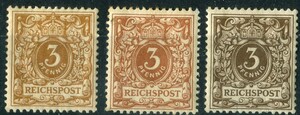SHADES

A huge and baffling range of shades can be found on many early revenue stamps. This is especially true for the United Kingdom revenues printed by De La Rue over the Queen Victoria era right through to QEII, or the wealth of lovely natural colours used in the smaller Indian Princely States.
As a catalogue editor, shades can be frustrating. I aim to record shades that are intended by the printer, or significant, but not otherwise. Significant means separable, so that shades can be given a clear name and different catalogue numbers. If shades can be sorted into two (or more) piles, without any doubtful ones, this is a help. If dates of use (by cancel, or if on dated document) supports the idea that a change occurred at a moment in history, this becomes significant. De La Rue did keep colour records for reference use when making new printings (and this is the source of some examples of stamps with SPECIMEN overprints); some colour changes by De La Rue from lilac to purple and then to claret were deliberate changes. So, lilac, purple, claret become significant in the catalogue.
When stamp production was not carefully controlled (e.g. the Indian States), colour shades can fan out evenly over a wide range. It just depended on the colour mix of the day, or how ink was applied to the rollers, or how well the press was cleaned after the previous job. For these, I use a basic colour name such as "green" or if the range of shades is large, then "green (shades)".
De La Rue introduced fugitive colours to try and combat fraud; the Inland Revenue feared that users would wash revenue stamps to remove pen cancels and re-use them. From around the 1880s they experimented with inks that would change colour in water. This explains the range of colours that emerged from the bath when collectors washed heaps of early revenue stamps clipped from old documents.
Sunlight affects colours too. Packets of stamps left in a shop window would fade over time (a very visible fault when overlapping but more of a puzzle when the whole stamp was over-exposed). These are basically damaged stamps, often too blue to be true. Atmosphere can change colours too; reds oxidise to brown (remember seeing brown Penny Reds?) from home coal fires or smoggy London town. John Mowbray explains that New Zealand stamps kept near Rotorua or other volcanic hot spots can oxidise in the same way, particularly affecting KGV era postage and revenue stamps including the 1927 Mortgage Indemnity 1/- stamp. So, don't leave your stamps too long near a volcano!
For exhibition purposes, it is best to seek stamps that are nearest to original colours. But as a private collector, there is fun in exploring the dramatic ranges of unintended colour changes, some from careless printing and some from poor aftercare. It can be spectacular!
- Published
- 17/06/20 12:07:00 PM
